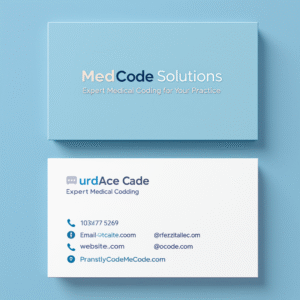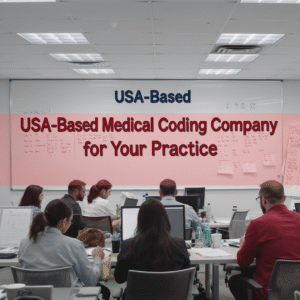Why Does Your Medical Practice Need a US-Based Coding Firm? The Decision That Can Transform Your Practice
Medical Coding Company
Medical Coding Company
A poor medical coding decision can cost your practice thousands of dollars in denials, fines, and lost time. Discover why choosing a U.S. company is the smartest investment you can make.
The Hidden Cost of a Bad Coding Decision
Real-life scenario: A cardiology practice in Miami decided to outsource its coding to an offshore company to save $3,000 per month. The result: In six months, they lost $45,000 in claim denials, faced a HIPAA audit for improper data handling, and Dr. Gonzalez had to hire additional staff to review and correct coding errors.
This story repeats itself more often than you might imagine. In the competitive world of American healthcare, where every code matters and every dollar counts, choosing your medical coding partner isn’t just an operational decision: it’s a strategic one that defines your practice’s financial future .

Medical Coding: More Than Numbers and Codes
What’s really at stake?
Medical coding isn’t simply converting diagnoses into alphanumeric codes. It’s the financial language that determines whether your practice thrives or survives. A coding error can mean:
- Immediate loss of income: Up to 30% of miscoded claims are denied
- Payment Delays: Errors can extend the collection cycle from 30 to 90+ days
- Audit Risk: Inconsistencies attract the attention of federal auditors
- Reputational damage: Compliance issues affect your professional credibility
The Pillars of Successful Coding
Technical Precision
- Correct application of ICD-10-CM, CPT and HCPCS Level II codes
- Accurate interpretation of clinical documentation
- Compliance with CMS guidelines and state regulations
Operational Efficiency
- Fast processing that accelerates the revenue cycle
- Minimizing reviews and corrections
- Seamless integration with existing systems
Regulatory Compliance
- Strict adherence to HIPAA and federal regulations
- Appropriate documentation for audits
- Protection against penalties and fines
The 7 Decisive Advantages of Choosing a US-Based Coding Company
🛡️ 1. Total HIPAA Protection: Your Shield Against Costly Breaches
The reality: Fines for HIPAA violations range from $100 to $50,000 per record, with annual maximums of $1.5 million.
Advantage of American companies:
- Innate knowledge of regulations: They operate under the same laws as your practice
- Robust Business Associate Agreements (BAAs): They fully understand their legal responsibilities
- Simplified audits: Your documentation meets standards recognized by US auditors
- Shared responsibility: They assume part of the legal risk of data protection
Contrast with offshore: Foreign companies, even if they claim to be “HIPAA compliant,” operate under different jurisdictions with varying enforcement standards.
🗣️ 2. Communication Without Barriers: Clarity That Translates into Precision
Common problem cases with offshore providers:
- Misinterpretation of regional medical abbreviations
- Confusion in specialized terminology
- Delays in resolving queries due to time differences
Advantage of American teams:
- Native fluency in medical English: Understands nuances, jargon, and abbreviations
- Same time zone: Real-time communication to resolve doubts
- Cultural context: They understand American medical practices

🎯 3. Certified Expertise: Proven Competence in the American System
Certifications that make a difference:
| Certification | Organization | Specialization |
|---|---|---|
| CPC | AAPC | Query encoding |
| CCS | AHIMA | Complex health systems |
| CCC | AHIMA | Advanced Coding |
| CPMA | AAPC | Medical audit |
Key benefits:
- Mandatory continuing education: Keep your skills up to date
- Specialization by medical specialty: Experienced coders in your field
- Payer Knowledge: Experience with Medicare, Medicaid, and private insurers
🎛️ 4. Total Control: Supervision That Generates Trust
Tangible benefits of close monitoring:
- In-person visits possible: Meet your team in person
- Immediate resolution: Problems solved the same day
- Operational transparency: Full access to processes and metrics
- Cultural alignment: Understanding the specific challenges of American practices
🔒 5. Enterprise-Grade Data Security: Protection That Doesn’t Compromise
Superior safety standards:
- Advanced technological infrastructure: Secure servers and protected networks
- Strict regulatory compliance: Subject to US data protection laws
- Regular security audits: Constant verification of protocols
- Incident Response: Locally Developed Contingency Plans
📈 6. Proven ROI: The Investment That Pays For Itself
Real case studies:
Orthopedic Consultation, Texas
- Before: 18% denial rate, 65 days collection time
- After: Denial rate of 4%, collection time 28 days
- ROI: 340% in the first year
Family Clinic, California
- Before: 2 in-house coding employees, cost $8,000/month
- After: Professional coding company, costs $5,500/month
- Additional benefit: 25% improvement in code accuracy
🇺🇸 7. Local Economic Impact: Investing in Your Community
Choosing an American company directly contributes to:
- Creating Local Jobs: Supporting American Professionals
- Regional economic growth: Strengthening the healthcare industry
- Innovation ecosystem: Promoting local technological development
⚠️ When to Consider Offshore Alternatives: An Honest Assessment
Scenarios where offshore could work:
✅ High volume, low complexity
- More than 1,000 monthly claims for routine procedures
- Specialties with standardized coding
- Robust internal audit systems
✅ Extremely limited budget
- New consultations with restrictive cash flow
- Practices in markets with very tight margins
- Willingness to invest significant time in supervision
✅ Internal supervisory capacity
- Staff with experience in coding auditing
- Established monitoring and quality control systems
- High regulatory risk tolerance
🚨 Warning signs that offshore is NOT for you:
- High-risk specialties (surgery, cardiology, oncology)
- Audit history or compliance issues
- Low to medium volume (less than 500 claims/month)
- Lack of internal resources for constant supervision
Your Step-by-Step Guide to Choosing the Perfect Coding Company
Phase 1: Needs Self-Assessment (Week 1)
📋 Internal evaluation checklist:
- [ ] Monthly claims volume: ___________
- [ ] Medical specialties: ___________________
- [ ] Current Systems (EHR/PMS): _______________
- [ ] Available budget: ___________________
- [ ] Current problems identified: ____________
- [ ] Improvement objectives: ____________________
Phase 2: Research and Pre-selection (Week 2-3)
🔍 Essential evaluation criteria:
Certifications and Credentials
- ✅ Current AAPC/AHIMA Certifications
- ✅ Specific experience in your specialty
- ✅ Continuing education history
Compliance and Security
- ✅ Security certifications (SOC 2, HITECH)
- ✅ Documented HIPAA policies
- ✅ Experience in audits
Technology and Integration
- ✅ Compatibility with your EHR/PMS
- ✅ Real-time reporting capabilities
- ✅ Backup and contingency systems
Phase 3: Detailed Assessment (Week 4)
📊 Key metrics to request:
| Metric | Minimum Objective | Excellent |
|---|---|---|
| Accuracy rate | 95% | 98%+ |
| Denial rate | <8% | <4% |
| Processing time | <24 hrs | <12 hrs |
| Response time | <4 hrs | <1 hr |
💬 Specific questions to ask:
About the team:
- “How many coders have experience in [your specialty]?”
- “What is your ongoing training process?”
- “Who will be my primary point of contact?”
About processes:
- “How do you handle urgent coding inquiries?”
- “What happens if an encoder is unavailable?”
- “What is your quality control process?”
About technology:
- “How do they integrate with [your specific EHR]?”
- “What kind of reports do you provide and how often?”
- “How do you protect data during transmission?”
Phase 4: References and Validation (Week 5)
🎯 Questions for references:
- “What has been your experience with coding accuracy?”
- “Have you had compliance issues working with them?”
- “How do you handle crisis or emergency situations?”
- “Would you recommend renewing the contract?”

The Real Cost: Detailed ROI Analysis
Cost Comparison Model (500 claims/month)
Option A: Offshore Company
Costo mensual: $2,000
Tasa de denegación promedio: 12%
Tiempo adicional de revisión: 15 hrs/mes
Costo de tiempo del personal: $450/mes
Pérdida por denegaciones: $8,400/año
COSTO REAL ANUAL: $32,850
Option B: Premium American Company
Costo mensual: $3,200
Tasa de denegación promedio: 3%
Tiempo adicional de revisión: 3 hrs/mes
Costo de tiempo del personal: $90/mes
Pérdida por denegaciones: $2,100/año
COSTO REAL ANUAL: $41,580
Option C: Efficient American Company
Costo mensual: $2,800
Tasa de denegación promedio: 5%
Tiempo adicional de revisión: 5 hrs/mes
Costo de tiempo del personal: $150/mes
Pérdida por denegaciones: $3,500/año
COSTO REAL ANUAL: $38,900
💡 The Complete Analysis
Additional factors to consider:
Hidden costs of the offshore option:
- Additional supervision time: $3,600/year
- Risk of fines for non-compliance: $2,000-$50,000+
- Lost productivity due to communication: $2,400/year
- Potential Actual Cost: $40,850 – $88,850+
Additional benefits of the American option:
- Regulatory tranquility: Invaluable
- Efficient communication: Savings of 20+ hours/month
- Protected professional reputation: Long-term value
- Real ROI considering intangible benefits: 250%+
Successful Implementation: Your 30-Day Transition Plan
Week 1: Preparation and Contracts
Days 1-3: Contract termination
- [ ] Legal review of the contract
- [ ] Signature of the BAA (Business Associate Agreement)
- [ ] Configuring secure access systems
Days 4-7: Technical preparation
- [ ] Setting up EHR/PMS integrations
- [ ] Connectivity and data transfer tests
- [ ] Establishment of communication protocols
Week 2: Training and Setup
Days 8-10: Team Onboarding
- [ ] Training sessions on your specific procedures
- [ ] Review of documentation templates
- [ ] Setting up custom workflows
Days 11-14: Pilot tests
- [ ] Sample processing of 50 claims
- [ ] Review and feedback of results
- [ ] Process adjustments as needed
Week 3: Gradual Transition
Days 15-21: Phased implementation
- [ ] Transfer of 25% of the volume
- [ ] Intensive quality monitoring
- [ ] Daily communication with the coding team
Week 4: Full Operation
Days 22-30: Total escalation
- [ ] Transfer of 100% of the volume
- [ ] Establishment of regular reports
- [ ] Evaluation of performance metrics
Conclusion: Your Practice Deserves the Best
In today’s competitive healthcare landscape, you can’t afford to compromise on the quality of your medical coding . The difference between an average coding company and an exceptional one isn’t just a few dollars a month—it’s the difference between sustainable success and constant worry.
The Benefits Are Clear:
✅ Guaranteed compliance that protects your reputation and license ✅ Seamless communication that eliminates costly errors ✅ Certified expertise that maximizes your revenue ✅ Data security that reassures your patients ✅ Proven ROI that improves your profitability
The Next Step Is Yours
The question isn’t whether you can afford to hire a quality U.S.-based medical coding company. The real question is: Can you afford not to?
Your medical practice is more than a business: it’s your professional legacy, the means to serve your patients, and your financial security. Don’t compromise its future to save a few dollars today.
Start your search today. Use this guide, ask the right questions, and choose the partner who will take your practice to the next level.
Your financial future, your peace of mind, and your patients will thank you.
Additional Resources
📞 Next Steps:
- Download our supplier evaluation checklist
- Schedule a free coding assessment consultation
- Join our monthly webinar on revenue cycle optimization
📚 Recommended Reading:
- “Complete HIPAA Compliance Guide for Medical Practices”
- “Revenue Cycle Optimization: Proven Strategies”
- “Trends in Medical Coding 2025”
Need help assessing your current coding situation? Our team of experts is available for a free, no-obligation consultation.



